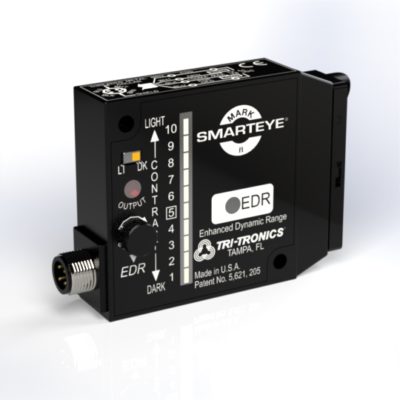Tri-Tronics Enhanced Dynamic Range (EDR)


The majority of traditional photoelectric sensors use a manual gain control to allow adjustment of the gain of the amplifier. By adjusting the gain of their amplifier, they can either decrease the gain to ignore some object, typically in the background, beyond the distance of the target, or, they can increase the gain to see some target object which is more difficult to see in the proximity mode (such as a dark colored object). When the sensor gain is decreased, it also makes it more difficult to see any object, including the intended target object.
The logical question is “why would you want to compromise the gain of the sensor and thus its ability to sense an object reliably, just to ignore or suppress something in the background? Wouldn’t it be more beneficial overall to operate the sensor at maximum gain 100% of the time, and resolve the application in a way that does not require this significant compromise?”
Circa 1986, Tri-Tronics introduced their unique, Smart-Eye sensor Series. It is to the best of our knowledge, the only photoelectric sensor on the market that is designed to maintain maximum gain, and uses a manual “Offset” adjustment instead to allow the operator to position that signal level anywhere on a scale of 0-10, with level 5 as a fixed, sensor switching point. In this manner, the operator chooses whether this signal level is sufficient to respond to or not, and where to sense the intended target and suppress the unintended background object. This unique design alone allowed the Smart-Eye sensor to be used where traditional sensors were compromised.
A further enhancement of their Smart-Eye sensor was introduced in 1995, with the Mark II Smart-Eye Series. It intelligently integrated control of the intensity of the LED source with the existing offset control. For a traditional sensor, as the sensor physically approaches a given target, the amount of light returned to the sensor increases, until at some point, the receiver becomes is saturated, and is not able to respond to any further increase in light returned. For this same application, with the Mark II Smart-Eye Series, as the operator naturally adjusts the offset counter-clockwise to maintain the desired response/switching point, the LED source intensity is reduced respectively, and receiver saturation is avoided, thus achieving an “Enhanced Dynamic Range” (EDR) of sensor operation; the sensor. This design allows effective operation of the sensor at close target ranges to highly-reflective targets. It also eliminates the need for typically reducing the aperture of the fiber-optics, to reduce the amount of projected light, when the application benefits from the sensor being close to the target; e.g, small targets.
Eagle Sensors & Controls is an Authorized Distributor of Tri-Tronics products (since 1989). Please contact us for technical, application, and sales support.
